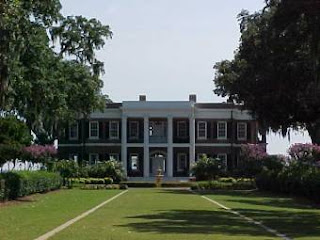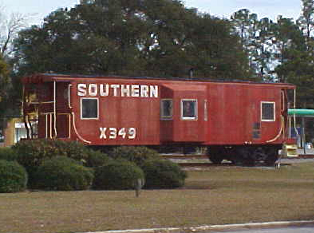
The Ford Plantation is a private, gated community and sporting club located at 12511 Ford Avenue, Richmond Hill, Georgia, approximately 18 miles southwest of the City of Savannah. Its 1,800 acres include nearly a mile of deep water frontage on the Ogeechee River which twists and turns and ultimately empties out into the Atlantic Ocean, 14 miles downstream. The Ford Plantation is located just south of Richmond Hill on Highway 144, and is approximately 15 miles via I-95 from Savannah-Hilton Head International Airport.

This picture was taken from the Ford Plantation. This is the beautiful Ogeechee River.

Bryan County is filled with these gorgeous live oaks.

Historic Bryan Neck Presbyterian Church was rebuilt in 1885. The church had burned in 1882. The manse was built by Henry Ford in a property trade with the church.

This is the home that Henry Ford built for himself. It is located in South Bryan at the Ford Plantation. Ford purchased the Hermitage Plantation in Savannah and used the bricks (Savannah 'greys', made at the plantation in the early 1800s) to build his house. Finished in 1938, Mrs. Ford had her Southern-style plantation house where she could grow a lawn and cultivate roses. Today, the house is used as a private Inn and meeting place for property owners at the new Ford Plantation.

This caboose is located in Pembroke to remind us of Pembroke's early days as a railroad town.

This is the old Pembroke Hotel.
Richmond Hill has a history that mirrors that of our nation: Exploration, Indian and Colonial settlements, the American Revolution, the War Between the States, Henry Ford Era, and recent military conflicts.
For centuries, the Guale people inhabited the shores of the Ogeechee River, enjoying the plentiful seafood and temperate climate. Spanish exploration in the late 1500s led to English settlement by 1792.
Prosperous rice plantations in the area were the "breadbasket" of the South, but the Civil War shifted this prosperity into poverty almost overnight. Fort McAllister, built in 1862 is one of our significant historical sites (now a Georgia state park). Originally the fort was built to protect Savannah's "back door.” Civil War buffs will tell you about the incredible stand the Rebels made against a new Yankee weapon, the ironclad, in the first sea-land battles in which this new class of warship was used. Nine distinct battles were fought involving the fort, including the final battle of General Sherman's March to the Sea, which ended in Bryan County.
Devastated after Sherman's March to the Sea in 1864, the desperate years of 1865-1925 found nearly 80 percent of county residents living at the poverty level, with malaria and moonshine dominating people's lives and livelihoods. An economic shot in the arm came when Henry Ford and his wife Clara visited Ways Station, as the town was then known, looking for a winter retreat. They built their winter estate on Sterling Bluff and set about erasing the impoverishment of Ways Station over the next 22 years. Ford’s philanthropic initiative saved Fort McAllister and enabled the fort to be reconstructed, and preserved for all to enjoy.
Eventually, Ford bought 85,000 acres, drained the swamps, constructed a sawmill, subsidized health care, built schools, a church, commissary, trade school, community house, and homes for his 600 employees. Ways Station was one of the most impoverished areas of Georgia. Ford sought to improve the quality of life and ultimately built 272 buildings on his property. With friends Thomas Edison and Harvey Firestone, Ford formed the Edison Botanic Society and conducted laboratory experiments, attempting to turn agricultural products into goods useful to the auto industry.
Ford Farms transformed former rice fields into fields of fine iceberg lettuce and grew 365 varieties of soybeans, testing their properties for extracting rubber. In 1941, the town was renamed Richmond Hill after Ford's estate. The Fords gave this small village a 20th-century rebirth through their philanthropic efforts, transforming the backwater town of Ways Station into a vibrant community with new schools and employment opportunities.
Today most of our historic resources are associated with the Henry Ford Era. Richmond Hill has been recognized and awarded as a Preserve America Community for preserving American heritage by the Advisory Council on Historic Preservation, the U.S. Department of the Interior, the U.S. Department of Commerce, the U.S. Department of Agriculture, and the U.S. Department of Housing and Urban Development on behalf of First Lady Laura Bush.
Most historic resources in Richmond Hill are associated with the Henry Ford Era. There are three types of properties related to the philanthropic and development activities of Henry Ford. There are the residential structures constructed for the employees of Henry Ford, commercial structures which were financed by Ford and the institutional buildings which housed religious, educational, and civic activities. Roughly 25 structures are being preserved with the intention of being listed on the National Registry. Some of the resources are just at the 50 year age requirement for eligibility for the National Registry Nomination. This includes:
Bryan County Court House
Community House
Martha-Mary Chapel
Richmond Hill School Teacherage
Commissary
Cannan Baptist Church
Kindergarten Building
Richmond Hill Plantation, currently on the National Registry
In 1939, Ways Station was renamed to Richmond Hill in honor of the Ford’s winter residence. The city was incorporated in 1962 with boundaries that contain approximately 3,720-acres. Subsequent annexations have almost doubled the current city size (6,535-acres). The county is physically divided by the Fort Stewart Military Reservation. Created prior to World War II, Fort Stewart occupies almost 109,000-acres of central Bryan County. Richmond Hill is located in the southern portion of Bryan County and is home to many soldiers and their families – the county’s fastest growing city.
Today Richmond Hill serves as a quiet family community, located just minutes from metropolitan Savannah. The city of more than 10,000 residents retains the small town charm. Richmond Hill has a great deal to offer to its residents; a diminished crime rate, outstanding educational opportunities, community services, recreational facilities, and beautiful scenery. This community has infinite potential. Richmond Hill offers relief from the hustle and bustle of the big city.
Quality growth and teamwork characterize Richmond Hill’s success. Southeast Georgia is one of the hottest business and residential growth areas in the country. Local businesses are aware of the unrivaled location advantages and the pro-business, pro-growth mentality of the local government. Richmond Hill borders the Fort Stewart Military Reservation and serves as home to many soldiers and their families. Families are aware the school system is top notch and the Board of Education is producing quality results. The schools continually exceed state standards and rank in the top 5% in SAT scores. Community involvement is evident in the motivated Parent Teacher Student Organizations. Neighborhood associations take pride in their neighborhoods and maintain the appearance. The Chamber of Commerce and the Convention and Visitors Bureau play an active role in the community as well as other active civic organizations. These partnerships enable the city and local businesses to work together towards effective growth. Citizen participation and community collaboration have led to creative solutions on development issues, prevention programs for the youth, and greater community understanding of good planning and investment.
The history of The Ford Plantation mirrors the history of this country. The plantation played important roles in the Revolutionary War, the Civil War and the industrial revolution. And it continues to play a prominent role in American society today as one of our premier Private Club Communities.
In 1733, General James Oglethorpe established the Colony of Georgia, named for King George II of England, and laid out its first city, Savannah. He barred slavery, rum and lawyers, seeing all three as contrary to the best interests of the new English settlement.
One of the earliest grants made by Oglethorpe was for 2,000 acres on the Ogeechee River at Sterling Bluff where present-day Ford Plantation sits. The grant was made to Hugh and William Sterling. The Sterlings ultimately abandoned the grant, the land passing to John Harn, who named it Dublin Plantation and began cultivating rice. In 1747, Harn planted the now massive live oaks that form the letter “H” at the entrance to The Ford Plantation.
After the Revolution and throughout the 1800s, rice cultivation at Dublin and Silk Hope Plantations reached new heights and fortunes were made.
The good times ended with the outbreak of the Civil War in 1861, when the Union blockaded the coasts of South Carolina and Georgia. Robert E. Lee, later Commander of the Army of Northern Virginia, served as the Commander of the Military Departments of the Coasts of South Carolina, Georgia and East Florida. Lee oversaw the construction of Fort McAllister at Genesis Point near Savannah, to protect the Confederacy’s “breadbasket.” It survived numerous attacks by naval forces, only to be destroyed in 1864 when General William Tecumseh Sherman conducted his “March to the Sea.”
In the early 1900s, the booming rice economy crashed, planters moved away and plantations fell into disrepair. It was at this time in 1923 that a stranger from Michigan unexpectedly appeared. Henry Ford, the world’s first billionaire, headed enterprises that included assembly plants, coal and iron mines, timber holdings, railroads, freighters and aircraft manufacturing, and employed more than 500,000 men. With the influence of his friends Harvey Firestone and Thomas Edison, Ford developed a keen interest in coastal Georgia – first as a place to grow rubber; then because it was home to an innovative school which Ford supported to the tune of $4 million; and, finally, because it had “a better climate and was a better place to winter than Florida.”
Ford started purchasing land, and when he finished he had accumulated 70,000 acres covering 120 square miles. He called his estate Richmond Hill. Addressing social and economic problems of the area gave Ford his greatest satisfaction and provided him with an escape from things that distressed him.
“Helping the people,” he said, “is my religion.” He championed causes to improve health care and education. He brought in doctors and nurses. He built clinics. He enlarged schools and brought in new educational equipment, libraries, movie projectors, radios, athletic equipment and most of all teachers. He built community houses and chapels.
In 1936, Ford broke ground for a beautiful Greek Revival style mansion of Savannah-gray brick with marble steps on the banks of the Ogeechee River. It featured a colossal portico and sweeping “Temple of the Winds” columns on both the front and river sides. The grand house had air conditioning and an elevator. It sat on 55 acres of manicured lawns and flowering gardens. It remains the centerpiece of The Ford Plantation today.
Ford’s ever-present birdhouses were tucked in appropriate places. He forbade hunting and before long deer and wild hogs began to abound and even wild turkeys became tame and frequented the lawn during the day. Steam plants and tunnels interlaced the estate, with a power plant located at the rice mill which had been left in ruins by General Sherman.
Ford suggested the entire town be renamed Richmond Hill and the town’s people eagerly agreed. The house became the center of social gatherings with visitations by the Vanderbilts, Rockefellers and the DuPonts.
Clara and Henry Ford made their last trip to Richmond Hill in the spring of 1947. Ford had suffered a stroke and returned to Dearborn on Easter Sunday, April 6. He died the next day at the age of 83.

No comments:
Post a Comment